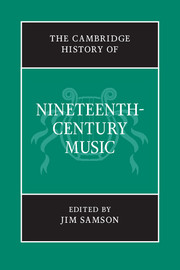Book contents
- Frontmatter
- Part One 1800–1850
- 1 The musical work and nineteenth-century history
- 2 Music And the rise of aesthetics
- 3 The profession of music
- 4 The opera industry
- 5 The construction of Beethoven
- 6 Music and the poetic
- 7 The invention of tradition
- 8 Choral music
- 9 The consumption of music
- 10 The great composer
- Part Two 1850–1900
- Chronology
- Institutions
- Personalia
- Index
- References
3 - The profession of music
from Part One - 1800–1850
Published online by Cambridge University Press: 28 March 2008
- Frontmatter
- Part One 1800–1850
- 1 The musical work and nineteenth-century history
- 2 Music And the rise of aesthetics
- 3 The profession of music
- 4 The opera industry
- 5 The construction of Beethoven
- 6 Music and the poetic
- 7 The invention of tradition
- 8 Choral music
- 9 The consumption of music
- 10 The great composer
- Part Two 1850–1900
- Chronology
- Institutions
- Personalia
- Index
- References
Summary
This chapter explores a rich seam within music’s economic and social history during the first half of the nineteenth century. Successive political and economic developments and demographic responses to them impacted heavily on musical culture, causing an exponential increase in the number of public concerts as well as rapid expansion in the worlds of music publishing, music journalism, music teaching, and instrument manufacture and sales. New musical professions sprang up as a largely urban music-consuming public voracious in appetite but variably refined in taste exerted growing financial power. Established professions either evolved in reaction to intense market pressures or disappeared entirely.
Certain obstacles make it difficult to chart the profession of music – or, more accurately, the professions of music – from 1800 to 1850. One is the sheer diversity of professional activities, which prohibits detailed investigation and watertight conclusions across the board. Another is the diversity of centres in which they were practised, ranging from capital cities to provincial locations in any number of different countries. A third is the diversity of consumers at the time – above all, the ‘middle class’, a socially disparate group with complex hierarchies of status and taste that defy concise summary. My approach is therefore highly selective, offering case-study illustrations drawn from a broad spectrum of professions, geographic locations and consumers, rather than a comprehensive coverage doomed from the start. Although eclectic, my strategy at least reflects the lack of cohesion within the profession of music itself during this period.
- Type
- Chapter
- Information
- The Cambridge History of Nineteenth-Century Music , pp. 55 - 86Publisher: Cambridge University PressPrint publication year: 2001
References
- 4
- Cited by

